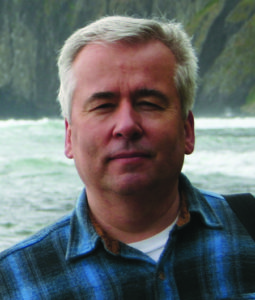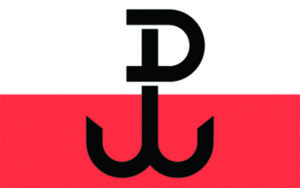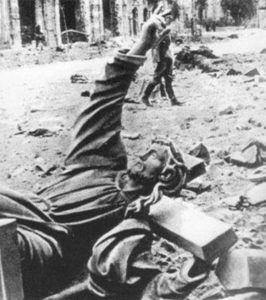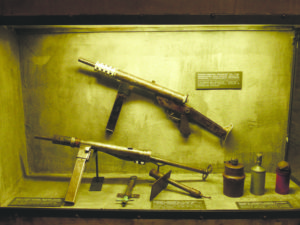

The West will never ever be broken.” These words, spoken by President Donald Trump in Warsaw are much needed today. But why Warsaw? On his West-ward mission, couldn’t he have picked a truly Western European city?
Today, Warsaw is geographically closer to Poland’s Eastern borders than to the West. Yet politically and culturally, she claims heritage of a truly Western city, while also a bridge to the East.
Trump’s speech was delivered at Krasinski Square, a large plaza in front of the Field Cathedral of the Polish Army, across Dluga (Long) Street, whose cobble stones were once soaked with the blood of Warsaw Uprising fighters.
At 5pm on August 1st, 1944, one of the most complicated dramas of modern history started unfolding.The Wehrmacht was in retreat ever since the Battle of Stalingrad turned the tide of WW II, a year-and-a-half before.

A Polish Army, formed in the USSR with the active help of Polish Communists, fought side by side with the Red Armies. The soldiers were recruited from the Polish population dispersed in the USSR after 1939, when Hitler and Stalin were still allies. Of all political stripes, they were united by a common desire to liberate Poland. Officers and the top command were hand picked by the Soviets and were loyal to them. The allied armies were advancing on Praga, the Warsaw district on the right (Eastern) bank of Vistula, comprising some 40% of the city.
On Polish territory, several underground groups operated, including the Home Army, loyal to the Polish Government in Exile in London. For months, they were preparing plans for an uprising, but there was no date set. Underground groups loyal to the Soviet Union were preparing too.

On July 22nd, Stalin established a puppet Polish government, Polish Committee of National Liberation (PCNL). While his insidious designs for Poland were not yet entirely disclosed, it was clear that whoever captured Warsaw would have an advantage in shaping Poland’s future.
The Red Armies were preparing an encircling maneuver to capture Warsaw, and despite claims that emerged later, possessed more than adequate supplies, including fuel and munitions, to launch a crushing offensive against the Germans, who were significantly outnumbered and whose high command considered the situation as alarming. Airfields in nearby Modlin and Deblin, respectively North and South of Warsaw, were at the Soviets’ disposal to launch airstrikes.
***

On July 27th, German authorities in Warsaw made a public announcement ordering 100,000 Polish men and women, ages 17 to 65, to report on the following day to start work on fortifications against the approaching Red Armies.
In the evening of July 29th, Radio Moscow broadcast in Polish a call to arms directed at the citizens of Warsaw. Similar broadcast was sent by a Polish Communist radio station “Kosciuszko” the next day, calling Poles to armed resistance. Soviet planes dropped leaflets urging Warsaw citizens to rise.

Citizens of Warsaw now faced a choice to report to work to resist the Soviet offensive, or to rise against the retreating Germans.
In the light of the inevitable, Home Army General Bor-Komorowski issued an order to start the uprising on August 1st. Communists joined too.
Stalin was taken by surprise, claim some historians today. This seems curious. Those days, one didn’t simply walk up to the mic in Moscow, and start a broadcast. Or print and drop plain loads of leaflets. Not usually without approval from the high command.
***
Warsaw had been a proud and intellectually independent city. She became the Capital of Poland in 1596 when Polish King Sigismund III Vasa moved his court from Cracow. Warsaw is much closer to Stockholm than Cracow, and Sigismund traveled to Stockholm from time to time. A marble column with his statue on the top, holding a cross in one hand and a sword in the other, was later erected in a large plaza in front of the Royal Castle in the Old Town. In 1611, in that very castle, Sigismund received a tribute from the Russian Czars, captured by the Polish troops, the only foreign army ever to enter Moscow uninvited. Centuries later, Polish communists marching into Poland along side of the Red Armies and trying to build a new friendship between the nations, had some explaining to do.
When in 1920 the Red Army was proceeding West, seemingly unstoppable, in its quest to “liberate” Europe from the old political and economic order and to establish the Soviet system across the continent, it suffered a sudden and inexplicable defeat in the Battle of Warsaw on August 15th, which like the battle of Stalingrad to come, completely turned the tide of victory, this time for the Polish forces. August 15th is a major Roman Catholic Feast of the Assumption of Mary, and the event was termed the Miracle at the Vistula.
Soviet leadership, including Stalin, never forgot this defeat from the hands of a newly reborn Polish Republic, near Warsaw, where for 123 years Russian was the official language, after the Partitions of Poland between Russia, Prussia and Austria in late 1700’s, which ended just 2 short years before, at the end of WW I. Polish-American hero Tadeusz Kosciuszko fought against the Russians before the partitions, and two unsuccessful insurrections, in 1830 and 1863, remind us of the will and the spirit of the Polish people.
Joseph Stalin’s vision for post-WW II Poland was that of a well-fed and happy pet bulldog on a short leash. A proud city with anti-Russian and anti-Soviet sentiments, challenging the new order marching in, was not part of that vision. The Warsaw Uprising presented an opportunity to the dictator to have the Germans clean up the proud city of undesired political element, and erase any memories that would challenge the new order. Unlike in Katyn, where Soviet secret police, NKWD, murdered tens of thousands of Polish military and paramilitary forces in 1940, and later blamed it on the Germans, this time cleaning up the proud city could be outsourced to the Germans willing to do the bidding with no questions asked.
***
The Soviet offensive to liberate Warsaw was halted, the mighty armies were ordered to rest. Allied planes flying supplies for the Uprising from air bases in Italy, were not allowed to use airfields on the East bank of Vistula, under the Soviet control, or to refuel. General Zygmunt Berling of the Polish Army, and King Sigismund’s namesake, launched strikes across Vistula and successfully captured several West bank bridgeheads near Warsaw, only to see his soldiers blown to smitherines by German panzers in the absence of adequate Soviet artillery and airforce support. Some supplies were later dropped by the Soviets, likely for PR purposes. The January 17th Soviet offensive next year was to eventually liberate Warsaw.
The uprising surrendered in early October. The fighters left the city, which was devastated by the fighting and by personal orders from Fuehrer. Pictures of Warsaw from that time are not much different than those of Hiroshima. In the 1960s, there were still piles of rubble in various parts of the city.
***
Warsaw Uprising is a subject of a controversy to this very day. Many families are still divided on this issue.
Evaluated militarily, the Uprising was an utter disaster. It completed the destruction of Warsaw, and claimed the lives of a whole generation of young Poles.
Its political gains are not clear and are disputed to this day. Stalin succeeded in implementing a Polish government loyal to him, and methodically, treacherously and ruthlessly stomped out all the political rivals.
Morally, Warsaw demonstrated its will to stand up to the very two evil political systems that cast shadow on the 20-th century. The Uprising Memorial in Krasinski Square reminds us that in the West, we consider some ideals worthy of not only living for, but dying for if needed. The monument has parts scattered across the plaza, much like the Uprising enclaves were scattered across the city, connected by sewers and passages like the Jerusalem Avenue Passage, mentioned by President Trump.
When the idea of a Monument to commemorate the Uprising was first suggested, the Communist government did not want to make a tribute to the Uprising, but only to its fighters. The narrative, consistent with the Soviet policy dating back to the uprising itself, was that the Uprising was a blunder of ruthless, decadent and stupid Polish leadership loyal to the London Government, with Warsaw people both its victims and heroes of the armed resistance. Recognizing the Uprising as such would ruin that narrative.
Over fifty years after Stalin’s cunning, Poland is a free nation again, able to praise not only its heroes, but the very ideals that animated them.
Warsaw is once again a part of the free West, and a bridge to the East.
References:
https://en.wikipedia.org/wiki/Warsaw_Uprising
Norman Davies, “Rising ’44, the Battle for Warsaw.”
Arthur Bliss Lane, I Saw Poland Betrayed: An American ambassador reports to the American people (The Americanist library).
http://www.1944.pl/en
https://en.wikipedia.org/wiki/Warsaw_Uprising_Monument
http://www.warsawuprising.com/witness/vaneyssen.htm
No Comments
Leave a comment Cancel